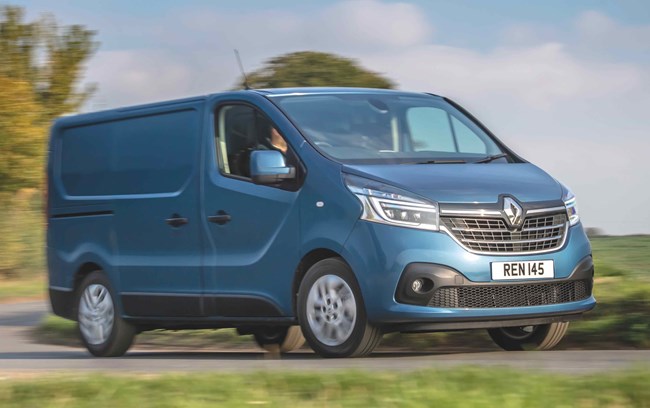- Remarketing: Pick of the bunch
- GA Commercial acquires first vans through Vanaways
- 'Luxury' tax on expensive pick-up trucks suggested
- ADVERTISEMENT FEATURE: Essential advice to avoid the van fleet ICE-berg
- ETRUX launches new Ford E-Transit Trizone
- Renault gives UK debut to Master E-Tech at CV Show
- Isuzu D-Max long-term test – Latest Report
- Isuzu D-Max V-Cross Steel Edition revealed
- IVOTY Report: Stellantis explores the hydrogen proposition
- New Maxus EVs include eDeliver 5 van
Buying a used... Renault Trafic (2014)
Date: Thursday, March 9, 2023 | Author: Ian Shaw
With facelifts and family feuds in later life, we look at a Trafic from simpler times.

The Renault Trafic is a child of the 1980s. With egg-box styling mimicking its bigger brother, the mini-Master made quite a name for itself and gave Renault a much bigger slice of the van market. It had a few re-styles throughout its teenage years (who didn’t?) before the second generation appeared in 2001. This took a leap forward and also sired the Vauxhall/Opel Vivaro, and Nissan Primastar in the process. Then in 2014 came the third true model type – ignoring mid-term facelifts – and carried the model through to 2022, when a revamp improved equipment levels and load volumes. By then the PSA group had bought Vauxhall-Opel, ousting the Vivaro as we knew it and Griffin-badging Citroën/Peugeot products throughout the weight-range. Here we shall concentrate on the pre-2022 version, in itself something of a bargain.
Two wheelbase lengths are available at 3.1 and 3.5m, giving overall dimensions of 5.1 and 5.5m respectively. These in turn, equate to load lengths of 2,535mm and 2,935mm with 1,662mm of load width (pinching to 1,269mm between the arches) and internal heights of 1,387mm and 1,897mm. These combinations then give four load volumes of 5.8m3 (L1H1), 6.7m3 (L2H1), 7.8m3 (L1H2) and 8.8m3 (L2H2) with the high roof giving a more significant benefit than some rivals.
Before 2019 the two GVM options were badged as 27 and 29 (for 2.7 and 2.9 tonnes) after that, up to 2022 they were 28 and 30, denoting 2,800 and 3,000kgs laden. Payload at best was 1,285kgs (after 2022 it dropped to circa 1,100kgs), so it’s a van for volume not tonnage. It can tow 2,500kgs however, which is impressive enough.
From 2019 onwards, the 2.0-litre common-rail diesel, dCi in Renault-parler, joined the 1.6-litre version with an automatic transmission option and better cab trim materials. All but the basic trim variants get the ‘mobile-office’ folding passenger seat backrest/table with additional storage beneath.
The usual raft of DAB and bluetooth with optional navigation, allied to good all-round visibility makes for a decent working environment. Seat comfort is good too, even for a long day, and while the 120hp version is no ball of fire the 140hp and 170hp units make for better progress. The torque curve is the key to it and the Trafic impresses much more at 7/10ths then it does if trying to wring its neck. The automatic is smooth enough, but the manual has a light gear shift and clutch action in any case. Noise levels are good, aside from wind noise above 60mph, in-cab storage is ample – do you really need more litreage in the door bins than the diesel tank? – while a low load floor height and wide aperture rear and side loading doors make it a multi-drop dream. The seat and door-step heights are well matched too. Its combination of comfort and standard kit combined with pre-22 model prices make it worth a serious look.
Five best options
1) 2.0 DCi 170 engine
2) Automatic transmission
3) Long wheelbase
4) High roof
5) Folding passenger seat
Five best avoided
1) 1.6 dCi 120 engine
2) Basic trims
3) Crew van
4) Short wheelbase
5) Low roof
Second-hand buys
|
Version |
Plate |
Year |
Mileage |
Price ex.VAT |
|
1.6dCi SL27 Sport |
67 |
2017 |
97,000 |
£9,999 |
|
1.6dCi SL27 Sport |
68 |
2018 |
67,000 |
£15,995 |
|
1.6dCi SL27 Business |
19 |
2019 |
67,000 |
£14,495 |
|
2.0dCi SL28 Energy |
70 |
2020 |
55,000 |
£21,995 |
|
2.0dCi SL28 Energy |
71 |
2021 |
15,500 |
£24,495 |
View The WhatVan Digital Edition


